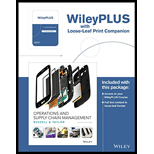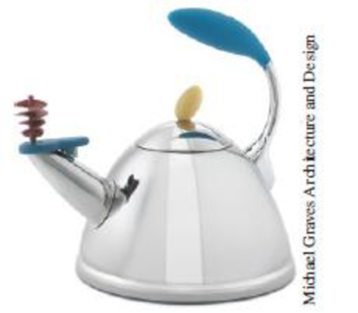
Concept explainers
Designing the Everyday
Michael Graves, probably best known for his singing teakettle sold at Target, was the first architect to have his own consumer brand of home products. His more than 800 product designs for Target helped the company differentiate itself from other big box stores and introduced the value of design to the American public. He also designed the scaffolding to protect the National Monument during major restorations, the Denver public library, walking sticks for Kimberley Clark, and more. Many years and design projects later, Graves fell ill and, wheelchair bound, turned his attention to “patient-centered health care design.”

When you think about it, the traditional wheelchair has a horrendous design. It is uncomfortable, difficult to get in and out of, hard to push and maneuver, and most egregiously, patients actually put their hands on the wheels that have been picking up debris and germs from the hospital floors to self-propel themselves. As seen in the photo, Graves’ design, produced by Stryker, has a more comfortable and cleanable molded seat with multi-formed armrests to aid entering and exiting the chair, smaller solid wheels located in the back out of reach of the patient, elevated handles and foot-operated brakes to alleviate back strain for the care provider, and a smaller footprint so multiple chairs can be stacked until needed. Attachments are not removable so they cannot be lost and are less likely to break. From the wheelchairs, Graves went on to design hospital beds and rooms, rehab centers, housing for wounded soldiers, elderly care facilities and ergonomically useful healthcare products. Although Graves passed away in 2015, the design firm that bears his name continues to win awards for patient-centered and customer-centric design.

Identify the different “customers” the new wheelchair design considered. How did Graves incorporate the process of using a wheelchair in his design?
Want to see the full answer?
Check out a sample textbook solution
Chapter 4 Solutions
Operations and Supply Chain Management, 9th Edition WileyPLUS Registration Card + Loose-leaf Print Companion
Additional Business Textbook Solutions
Principles of Operations Management: Sustainability and Supply Chain Management (10th Edition)
Operations Management: Processes and Supply Chains (11th Edition)
Operations Management
Business in Action
Business in Action (8th Edition)
Operations Management, Binder Ready Version: An Integrated Approach
- How can we Evaluate Design Alternatives?arrow_forwardWhat is the golden rule of design?arrow_forwardseveral fast food chains, after their success with offering customers fresh salads and do downplay the image of selling unhealthy food began adding fresh fruit plates to their menus. At about the same time and seemingly in direct conflict with this "healthy "strategy several other fast food chains began offering fat and calorie laden items to their menu. Using the above senario : write about factors that cause organizations to redesign their product and sevices.arrow_forward
- How could it possibly be a waste of effort to segment a design into user needs?arrow_forwardDescribe 3 ways service design differs from product design. Describe 2 ways they are similar.arrow_forwardcritically evaluate how does tesla use the double diamond approach in its product design approach , what design thinking tools are used ?arrow_forward
- Identify and briefly discuss the key elements that you need to remember when you design-thinking.arrow_forwardExplain user‐centered design and list three of its important principlesarrow_forwardThere are a range of factors that can cause an organization to design or redesign a product or service. Choose two factors and give examples of how they would impact a product or service.arrow_forward
- For an extended period, you have used pens and mechanical pencils. Please borrow five pens and mechanical pencils. The topic of discussion pertains to the criteria for design. This prompt invites a discussion of the advantages and disadvantages of design. Please provide visual representations for each of the designs. Please prepare a report summarizing the findings of your research. The report should be between 1 and 2 pages in length and should include a clear and concise description of your results.arrow_forwardWhy do you think we need design thinking? How does this relate to solving complex problems?arrow_forwardWhat are three specific ways in which comp uter-aided design(CAD) benefits the design engineer?arrow_forward
 Practical Management ScienceOperations ManagementISBN:9781337406659Author:WINSTON, Wayne L.Publisher:Cengage,
Practical Management ScienceOperations ManagementISBN:9781337406659Author:WINSTON, Wayne L.Publisher:Cengage, Operations ManagementOperations ManagementISBN:9781259667473Author:William J StevensonPublisher:McGraw-Hill Education
Operations ManagementOperations ManagementISBN:9781259667473Author:William J StevensonPublisher:McGraw-Hill Education Operations and Supply Chain Management (Mcgraw-hi...Operations ManagementISBN:9781259666100Author:F. Robert Jacobs, Richard B ChasePublisher:McGraw-Hill Education
Operations and Supply Chain Management (Mcgraw-hi...Operations ManagementISBN:9781259666100Author:F. Robert Jacobs, Richard B ChasePublisher:McGraw-Hill Education
 Purchasing and Supply Chain ManagementOperations ManagementISBN:9781285869681Author:Robert M. Monczka, Robert B. Handfield, Larry C. Giunipero, James L. PattersonPublisher:Cengage Learning
Purchasing and Supply Chain ManagementOperations ManagementISBN:9781285869681Author:Robert M. Monczka, Robert B. Handfield, Larry C. Giunipero, James L. PattersonPublisher:Cengage Learning Production and Operations Analysis, Seventh Editi...Operations ManagementISBN:9781478623069Author:Steven Nahmias, Tava Lennon OlsenPublisher:Waveland Press, Inc.
Production and Operations Analysis, Seventh Editi...Operations ManagementISBN:9781478623069Author:Steven Nahmias, Tava Lennon OlsenPublisher:Waveland Press, Inc.





